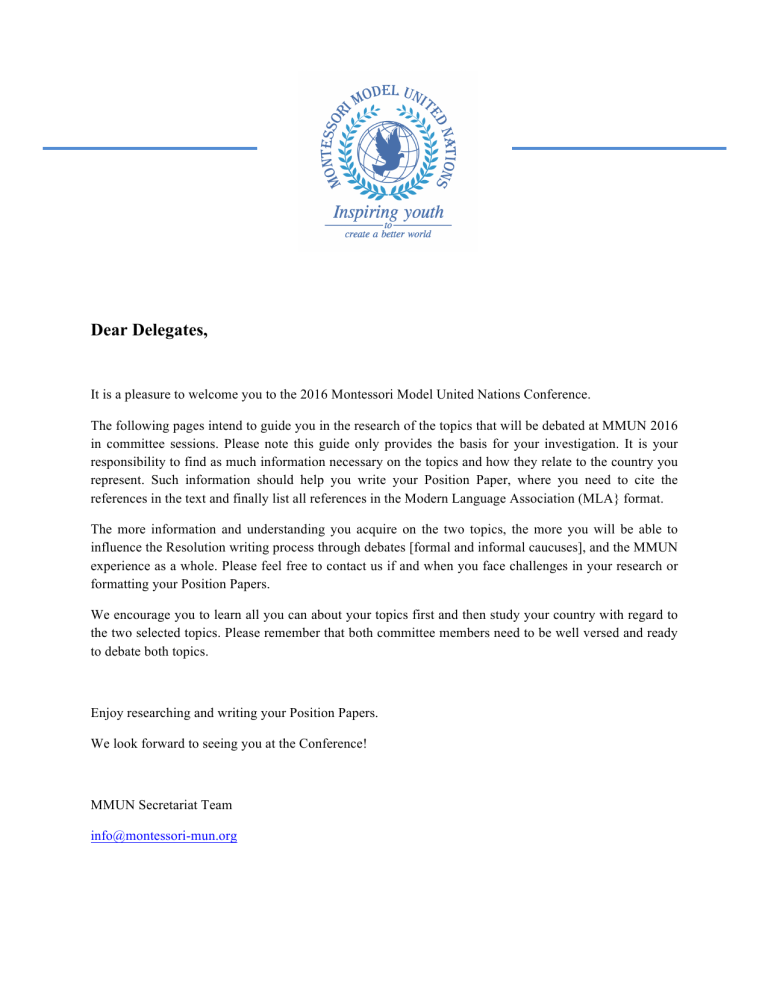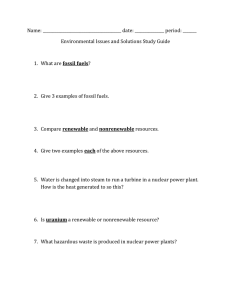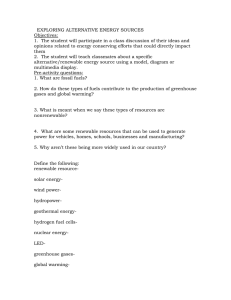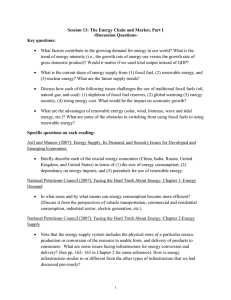Increasing Access to Renewable Energy

Dear Delegates,
It is a pleasure to welcome you to the 2016 Montessori Model United Nations Conference.
The following pages intend to guide you in the research of the topics that will be debated at MMUN 2016 in committee sessions. Please note this guide only provides the basis for your investigation. It is your responsibility to find as much information necessary on the topics and how they relate to the country you represent. Such information should help you write your Position Paper, where you need to cite the references in the text and finally list all references in the Modern Language Association (MLA} format.
The more information and understanding you acquire on the two topics, the more you will be able to influence the Resolution writing process through debates [formal and informal caucuses], and the MMUN experience as a whole. Please feel free to contact us if and when you face challenges in your research or formatting your Position Papers.
We encourage you to learn all you can about your topics first and then study your country with regard to the two selected topics. Please remember that both committee members need to be well versed and ready to debate both topics.
Enjoy researching and writing your Position Papers.
We look forward to seeing you at the Conference!
MMUN Secretariat Team info@montessori-mun.org
United Nations Environment Assembly
(UNEA)
UNEA was a result of the call made by world leaders at the United Nations
Conference on Sustainable Development (Rio+20), held in Brazil in June
2012, to strengthen and upgrade UNEP as the leading global environmental authority that sets the global environmental agenda and by establishing universal membership in its Governing Council. Subsequently, at the first universal session of the UNEP
Governing Council held in February 2013, Member States recommended to the UN General Assembly that the Governing Council, the 58-member governing body of UNEP in place since 1972, be renamed the
United Nations Environment Assembly of the United Nations Environment Programme with universal membership. In March 2013, the General Assembly adopted resolution A/RES/67/251 , formally changing the designation of the Governing Council to the “United Nations Environment Assembly”. Now all the
193 United Nations Member States, Observer States and other stakeholders participate in discussions and decision-making on issues that affect the state of the environment and global sustainability.
Source: http://www.unep.org/unea/about.asp
Website: www.montessori-mun.org
Email: info@montessori-mun.org
These background guides were provided by our Model UN content partner, Best Delegate.
© Copyright Best Delegate LLC 2015, all rights reserved.
Renewable Energy
Topic Background
Climate change and its negative effects have become an important issue for countries to address.
Many countries are looking for different energy sources that would cause less environmental damage. Fossil fuels such as petroleum and coal remain the most used energy source. Fossil fuels are formed from the natural decay of organic material such as plants or animals. Fossil fuels are considered a nonrenewable resource because they take millions of years to be created. They have a negative impact on the environment because when fossil fuels are burned, they produce gases.
These gases can become trapped in the earth’s atmosphere and do not allow the sun’s energy to escape from the atmosphere. This causes the earth’s temperature to rise and leads to harmful environmental effects.
1
The current methods of producing, refining and utilizing energy have negative impacts on the environment. Not only does the burning of fossil fuels damage the environment, but it can also cause serious health problems for people. Coal is often burned in order to produce electricity.
Gases are released when coal is burned and enters the atmosphere as air pollution, which can affect people’s health by causing respiratory issues such as asthma.
2
Renewable energy is a sustainable alternative source of energy compared to fossil fuels.
Renewable energy sources do not contribute to the negative impact on the environment.
Renewable energy can be used immediately and do not run out. The world relies heavily on fossil fuels to power automobiles, heat homes, and power other utilities. However, the earth’s supply of fossil fuels is rapidly diminishing as demand continues to increase. Possible alternatives to fossil fuels are solar power, hydropower, tidal power, wind power, geothermal
energy, and even nuclear energy, though it is a controversial form of power. These types of renewable energies are non-polluting and replenishable making them a better option than fossil fuels.
3
Many countries have begun to utilize alternative energies, though the conversion from fossil
fuels to alternative energies is slow:
● The United States gets approximately 84% of its energy from fossil fuels. As of 2014 the U.S. is making strides to use more alternative energy with 10% of total energy consumption as renewable sources and 13% of electricity produced from renewable sources. In the summer of 2015, President Barack Obama announced the “Clean Power
1
"Why Are Fossil Fuels Bad for the Environment?" Why Are Fossil Fuels Bad for the Environment?
January 10, 2013.
2
"Types of Renewable Energy." RE News RSS . January 6, 2013.
3
"Effects of Air Pollutants - Health Effects." EPA . Environmental Protection Agency. January 8, 2013.
Website: www.montessori-mun.org
Email: info@montessori-mun.org
These background guides were provided by our Model UN content partner, Best Delegate.
© Copyright Best Delegate LLC 2015, all rights reserved.
Plan” which is “the biggest most important step we’ve ever taken to combat climate change”. The Plan will require states to meet specific carbon emission reduction measures based on their energy consumption. The U.S. also has multiple government agencies that monitor the environment; its effect and use of renewable resources such as the Environmental Protection Agency (EPA), The
Department of Energy (DOE), Natural Resources Conservation Service (NRCS), and many others.
● Brazil , a developing country, is one of the leading examples of a developing country using renewable energy rather than fossil fuels. 85.4% of all of Brazil’s energy comes from renewable resources, particularly sugarcane ethanol which the country has in abundance. In 2014, Brazil was one of the top countries which invested in renewable sources with approximately $7.6 billion. After an oil shortage in the 1970s, Brazil focused on developing renewable energies, which is the reason behind their advanced use of these energy sources.
● The People’s Republic of China is rapidly developing its use of renewable energy.
China has begun to invest more capital in its renewable energy program during the 2000s focusing specifically on hydropower and nuclear power. In 2014, China was the highest contributor to the renewable energy sector. However, China still mines and uses coal for energy and the environmental recovery from this has been very slow.
There are grave international consequences if the world does not begin to move away from fossil fuels and increase its use of alternative energies. The greatest threat that fossil fuels pose is to the environment. Global warming is an important issue that cannot be ignored. If something is not done to slow and stop such large carbon emissions, people can expect to see an increase in unusual and strong weather patterns such as hurricanes and droughts, the spread of disease, rising sea levels, an increase in temperature, and the depletion of natural resources. This is an issue that affects the entire world and can prove very dangerous if something is not done by the international community to address it and make strides toward solving the issue.
Past International Actions
The United Nations outlined the importance of access and implementation of renewable energy when it drafted the Millennium Development Goals (MDGs). Goal 7 in particular deals with ensuring Environmental Sustainability. The MDG goal 7 wished to integrate principles of sustainable development into government policies in order to reverse the loss of important environmental resources, such as forests and biological diversity.
The United Nations Environment Programme (UNEP) is a United Nations body that focuses on promoting the environment, providing environmental program assistance to developing nations, issuing reports on a wide range of environmental issues, and works to create international conventions and protocols that protect the environment.
Website: www.montessori-mun.org
Email: info@montessori-mun.org
These background guides were provided by our Model UN content partner, Best Delegate.
© Copyright Best Delegate LLC 2015, all rights reserved.
The United Nations Framework Convention on Climate Change (UNFCCC) states that the environment is a resource utilized by all nations and it is the responsibility of each nation to protect it. The convention was introduced in 1992 and came into effect on
March 21, 1994, when it was ratified by a majority of member states. The convention specified that governments should work together to minimize the environmental damage caused by fossil fuels and look for alternative energy sources. Importantly, the convention also pressured
developed nations to reduce their own emissions, as developed countries cause the majority of greenhouse gas emissions. Although many member states ratified the convention, it has not been upheld to the fullest extent possible.
4
On December 11, 1997, the Kyoto Protocol was introduced. The Kyoto Protocol is an amendment to the UNFCCC, which includes legally binding environmental goals for countries to meet from 2008-2012. If the member states met the requirement, it would cut greenhouse gas emissions by 5% from the 1990 level. The Kyoto Protocol also included emissions trading. This allowed countries that have surpassed their emission allotment to purchase emission credit from countries that stay within or below their own limits. Emissions trading allowed for underdeveloped countries to benefit financially from cutting their emissions.
5 However, the
Kyoto Protocol ran into some issues, as the United States, and China, which were among the
world’s largest users of fossil fuels did not sign on to the Protocol, thereby diminishing the legitimacy of the protocol in many nations’ eyes.
There are multiple governmental and non-governmental organizations that are working toward employing more environmentally friendly renewable energies versus the fossil fuels currently being used. The UNEP is an example of such an organization.
6 The UNEP’s Risoe Center on
Energy Climate and Sustainable Development (URC) works, particularly with developing
nations, to promote the development and use of renewable energies.
One current nongovernmental organization that focuses on renewable energy is the Renewable
Energy Agency (REA). The REA was founded in 2003 with the goal of protecting the environment by using renewable energies, informing the public on the use of renewable resources, and promoting research on the issue. REA works with international organizations and governments to promote the research and implementation of renewable energy. REA is currently working on the study of the potential of anaerobic digestion technologies implementation in agriculture of Ukraine with US EPA Assistance, A Landfill Gas Feasibility Study and Collection
4
"United Nations Framework Convention on Climate Change." United Nations Framework Convention on Climate Change .
January 7, 2013.
5
"Kyoto Protocol." Kyoto Protocol . January 10, 2013.
6 "United Nations Environment Programme (UNEP) - Home Page." United Nations Environment Programme (UNEP) - Home
Page . January 8, 2013.
Website: www.montessori-mun.org
Email: info@montessori-mun.org
These background guides were provided by our Model UN content partner, Best Delegate.
© Copyright Best Delegate LLC 2015, all rights reserved.
System and Flare Installation at The Rivne Landfill, Publishes the Ukrainian magazine
“Green Energy,” and has multiple other projects. 7
Possible Solutions
There are many areas where the United Nations can promote the development of renewable
energy:
● Solar and Wind: India, for example, is rated as the top producer of solar energy in the world. A third of India’s energy comes from renewable sources.
8 In Brazil, wind power is
one of the fastest growing sources of energy. Although the costs of renewable energy is rising, the government remains committed to developing wind power and other sources of renewable energy.
9
● Hydropower: The country of Zimbabwe built mini-hydropower plants to provide energy for citizens living in rural areas, resulting in less environmental degradation.
10 The
Republic of Korea is building tidal power plants along its coasts. The country is investing more than $1 billion over the next couple years to build more plants.
11
● Nuclear Energy: The Department of Energy in the Philippines is considering reviving the Bataan Nuclear Power Plant to help the country with its energy needs, but it is stirring local and international protest.
12
Delegates of their respective countries must look for a viable solution to increase the access of renewable energy sources and look for solutions to combat the environmental effects carbon emissions have inflicted
on the Earth. Delegates are urged to work together to create sustainable means for development and environmental measures.
7
"About Agency." About Agency . Renewable Energy Agency, January 9, 2013.
8 Green, Hannah. “Will India Surge Ahead Of The West In Renewable Energy?” Think Progress. November 30, 2012. http://bit.ly/11r6pUG
9 Hubner, Nelson. “Brazil's Wind Power Auction Spurs More Clean Energy Development.” Renewable Energy World. December 29,
2009. http://bit.ly/7mr1Vd
10
“Zimbabwe: Mini-Hydro Power Station Changes Lives.” allAfrica. November 11, 2012. http://bit.ly/RN7cwf
11
“S.Korea to invest $1 bln in tidal power plants.” Reuters. March 25, 2010. http://reut.rs/jbYG6u
12
“NGO slams revival plan of Bataan nuclear plant.” Sun Star Iloilo. January 11, 2013.
Website: www.montessori-mun.org
Email: info@montessori-mun.org
These background guides were provided by our Model UN content partner, Best Delegate.
© Copyright Best Delegate LLC 2015, all rights reserved.
Further Research
Guiding Questions
1.
What incentives can we use to promote the use of renewable energy?
2.
How can we best implement these forms of renewable energy?
3.
How can we make renewable energy more affordable and practical?
4.
What is the timeline for when member states should begin the switch from fossil fuels to renewable energy?
Research Sources
● UNEP Activities in Energy
● United Nations Framework Convention on Climate Change
● The State of Sustainable Development
Questions :
1. What are some ways to mitigate carbon emissions?
2. What international agreements exist regarding climate change?
3. What has President Obama announced for new climate change initiatives in the United States?
4. What do the Millennium Development Goals say about climate change and the environment?
5. What is emissions trading?
Answers:
1. Tax incentives, carbon emission taxes, and research and development incentives
2. Kyoto Protocol and UNFCCC
3. He announced the “Clean Power Plan” which is “the biggest most important step we’ve ever taken to combat climate change.”
4. The MDG goal 7 wished to integrate principles of sustainable development into government policies in order to reverse the loss of important environmental resources, such as forests and biological diversity.
5. Emissions trading allows countries that have surpassed their emission allotment to purchase emission credit from countries that stay within or below their own limits. Emissions trading allowed for underdeveloped countries to benefit financially from cutting their emissions.
Website: www.montessori-mun.org
Email: info@montessori-mun.org
These background guides were provided by our Model UN content partner, Best Delegate.
© Copyright Best Delegate LLC 2015, all rights reserved.


